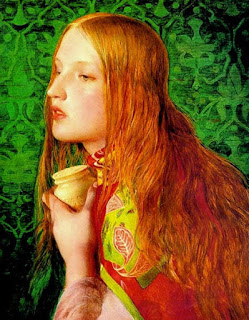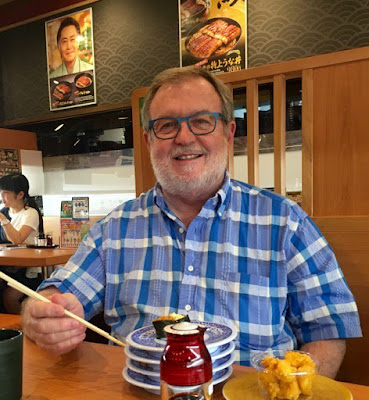 |
| Michael Haydn |
One of my favorite LP sets is a 1978, 4-disc set called “Orgelmeister vor Bach” (The Early German Organ School), performed by Helmut Walcha. Walcha (1907-1991) lost his sight as a teenager but nevertheless mastered a large organ repertory, including Bach’s complete organ works. This website discusses his achievements:
http://www.bach-cantatas.com/Bio/Walcha-Helmut.htm
A friend who is a professional musician recommended this out of print set, if I could ever find it. While on a roadtrip to Tucson, I saw it for sale at the wonderful, now closed Jeff’s Record Shop. The set was 40-some dollars and I worried about the price, so I didn’t buy it, and of course I couldn’t find the set again, even on eBay. Finally I found it on that auction site. Then I saw it again on eBay just a few weeks later, at an even better price. Oh well.
Buxtehude (the sound of whose name makes me chuckle, for some reason) dominates the organ masters on these LPs. Listening to the set while working, I found myself enjoying particular pieces and, looking at the label, discovered they were by Pachelbel. Poor Pachelbel! Like Albinoni with his Adagio, Barber with his own Adagio, Mouret and his Rondeau (the Masterpiece Theater theme), Delibes and the Flower Duet from
Lakme, and some other composers, Pachelbel is best remembered for one piece of music. But they all wrote other, beautiful works, too. The Walcha set also includes music by Lübeck, Scheidt, Bruhns, Sweelinck, Tunder, and Böhm.
This past weekend, I thought again of the way many of us---unless we're specialists or dedicated amateurs---neglect beautiful music written by less notable composers. The list of other
classical-era composers is long, though Mozart and Joseph Haydn command much of the attention.
A few years ago I discovered the symphonies of Michael Haydn, Joseph's brother, and have them on several CDs. Also, one of my Pandora channels is Michael Haydn, which provides a great selection of classical-era music by him and numerous others. This past Sunday, as Beth and I worked on writing projects at home, I turned on the Michael Haydn channel and jotted down the several featured pieces and their composers:
Michael Haydn, Symphony in F Major, MH 507 (P 32)
William Herschel, Oboe Concerto in C Major
Christian Cannabich, Symphony #64 in F Major
C.P.E. Bach, Symphony for 2 flutes, 2 horns, strings and continuo, H 649, Wq 174
Franz Ignaz Beck, Sinfonia in E Major, Op. 131
Karl von Dittersdorf, Sinfonia in A Major
Georg Anton Benda, Symphony #1 in D Major
Francois-Joseph Gossec, Symphony in G Major, Op. 12/2 (B 55)
Joao de Sousa Carvalho, L'amore Industioso (opera overture)
Antonia Rosetti, Symphony #24 in F Major
Johann Friedrich Fasch, Ouverture (Suite) in D Minor
Michael Haydn, Symphony in B-flat Major, MH 82 (P9)
Franz Xaver Richter, Sinfonia #4 in F Major (6 Grandes Symphonies #2)
Antonio Vivaldi, Oboe Concerto in C Major, RV 451
Wilhelm Heerschar, Symphony #12 in D Major
George Fridrich Handel, Water Music Suites 1-3, HWV 348-350
Antonio Salieri, Symphony in D Major "Veneziana"
Giovanni Battista Sammartini, Symphony (Overture #1) in A Major for 2 trumpets, 2 violins, viola, and bass
Johann Ernst Hartman, Symphony #1 in D Major
Michael Haydn, Flute Concerto in D Major
J. C. Bach, Symphony for Double Orchestra in D Major, Op. 18/3
Leopold Hofmann, Sinfonia in F Major
When we left the house to do something, I turned the radio off just as the next featured composer was Luigi Boccherini.
I like the music of these composers---Michael Haydn and also Boccherini, Vivaldi, Handel, the Bach family, and good ol' Salieri---but I was unfamiliar with even the names of other composers. Yet the musical enjoyment they afforded during our peaceful afternoon was wonderful. It would be a worthwhile effort, for any of us amateur music lovers, to select a musical period that we like and go off-road, so to speak, to discover music by less-well-known artists. We might discover pieces we can't now do without.
(Serendipity: the July 2016 issue of "Gramophone" has a review (pp. 38-39) of some new recordings of other lesser-known 18th century composers. They include Georg Benda and Michael Haydn and also Carl Stamitz, the brothers Paul and Anton Wranitzky, Johann Matthias Sperger, and Franz Anton Hoffmeister. The reviewer, David Thresher, writes, "There's more to the musical late 18th century than Mozart and Hydn, and sometimes it doesn't hurt to be reminded of the fact. There were hoards of Kapellmeisters and composers working alongside the two giants of the Austro-German Classical word, most of whom are now remembered as little more than names in dusty music dictionaries. New discos from Sonly Classical... [raise] hopes that they may be harbingers of a continuing series of recordings of the works of these mostly forgotten
Kleinmeister.)
 On the Roman Catholic and Episcopal calendars, Ignatius Loyola (1491-1556) is honored today, the anniversary of his death. There is even a hashtag, #IgnatiusDay, on Twitter! He was a Spanish knight, born Íñigo López de Loyola, who became a priest in 1537, founded the Society of Jesus in 1541, and through his Spiritual Exercises and spiritual guidance he became a still-popular author of Christian spirituality, appreciated by non-Catholics as well as Catholics. Here is a summary of his life: http://www.catholic.org/saints/saint.php?saint_id=56
On the Roman Catholic and Episcopal calendars, Ignatius Loyola (1491-1556) is honored today, the anniversary of his death. There is even a hashtag, #IgnatiusDay, on Twitter! He was a Spanish knight, born Íñigo López de Loyola, who became a priest in 1537, founded the Society of Jesus in 1541, and through his Spiritual Exercises and spiritual guidance he became a still-popular author of Christian spirituality, appreciated by non-Catholics as well as Catholics. Here is a summary of his life: http://www.catholic.org/saints/saint.php?saint_id=56











